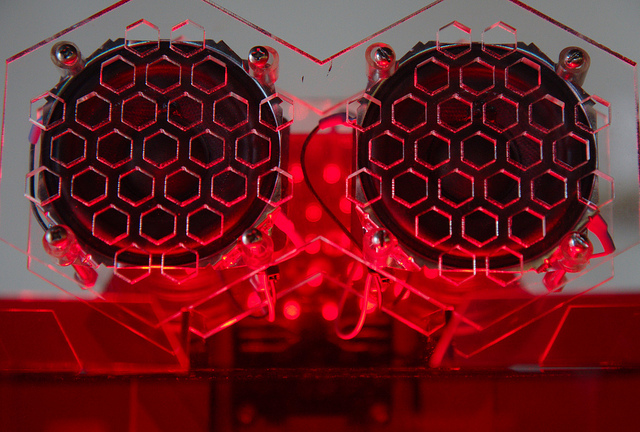Lasers are used in many industries to treat people, detect motion and manufacture products. Computer-controlled (CNC) laser cutting, marking and engraving machines are a convenient way to create industrial and custom consumer products like signs, badges, gears, tags, e t.c. There are various CNC laser-based machines that allow running different types of tasks depending on a specific application.
Laser Cutting is a process of manufacturing parts by directing a laser beam onto the material to cut out a specific geometry. The laser is focused on a spot with the help of optics and computer code to melt or burn out the exes material.
Laser Engraving and laser marking are relatively similar processes - the difference is that they will just remove a top layer (or a few) of material to leave the details on the surface.
Lasers can also engrave the color into a material. Usually, the process is referred to as laser marking, which allows oxidizing the material until it changes the color to a specific one. By controlling the length of a laser wave and speed, material type and surface finish, many colors can be achieved.
There are some alternative laser marking methods as well: these include creating a cavity on the acrylics, putting a dye and engraving the surface again with lower power and higher speed to melt the dye into a workpiece.
The laser cutting process can be described as melting because what the laser beam does is melts or evaporates the extra material, which you don’t need on the workpiece.

Image by Artisan Model Makers
In order to get different types of results or work on specific materials, laser cutters should meet power, heat output, intensity and wavelength parameters. Delicate materials such as fabric, leather or paper are cut with less powerful lasers to avoid overheating. On the contrary, tough workpieces i.e. gemstones, metals and thick objects require high power cutters.
The CO2 laser is one of the most common types used in cutters. It operates through an electrically stimulated dioxide mixture. Modern CO2 lasers use radiofrequency energy instead of the electrodes. The older versions weren’t completely risk-free since the electrodes inside a cavity could face an electrode erosion.
Nd: YAG Lasers use crystals and laser diodes or flashlamps to pump the beams, which results in large cutting capabilities. Therefore, these crystal lasers are commonly used in welding, industrial-grade cutting, and manufacturing.
Fiberglass laser uses a "seed laser" that is amplified by glass fibers and diodes. This type is much stronger compared to CO2, and it can be used on both metal and non-metal materials.
Laser cutters are considered more precise compared to mechanical mills. Additionally, they deliver nice, smooth and sealed edges of parts, which allows skipping some post-processing.

Image by: Steve Rainwater
Laser engraving is used widely for automotive, tooling, electronics, medical, military, aerospace, oil & gas and much more. In these industries, laser engraving and marking are widely used on a daily basis. Speaking of certain end-use and consumer products, laser engraving is a popular method of customizing existing goods and creating low-volume collections by amateur designers.
Both CNC milling and laser cutting are widely used methods of subtractive manufacturing. They can partially replace each other but there are particular situations in which one of the technologies is more preferable.
Lasers deliver less post-processing on edges compared to mechanical mills. Usually, it’s a uniform cut around the whole product despite the intricacy of some areas. Burrs, discoloration and small deformity can still occur in the process depending on the material and laser type but the average results tend to be much smoother compared to a mill. With no direct contact between tool and material, laser cutting avoids accidental contamination.
A laser beam is generally more precise and provides a smaller possible radius. Finally, CNC mills put pressure and heat on the workpiece during the process, which can cause cracks and warping.
However, lasers aren’t ultimately better than mechanical mills. They lose in terms of making square shapes and are worse in working with aluminum (compared to CNC punching).
Compared to mechanical CNC, laser cutter makes parts quicker with a few exceptions like large batches of simple shapes which are quicker to make via punching or CNC routing. Aside from cutting being quicker, the whole manufacturing process takes less time with less post-processing and preparation.
Some CNC milling machines are capable of making 3D geometries, while laser cutters are tied to 2D format only. In order to determine a range of materials any specific cutter can allow processing you want to look at RPM capabilities and bits for mechanical CNCs and laser type and power for laser cutters.
On average, laser cutters are limited in terms of materials they can handle. Many laser cutters are unable to work with crystals, glass, aluminum, copper and some other materials that are too brittle, transparent or light reflective. Machines that enable cutting crystals or glass are present on the market but commonly very expensive.
Some desktop laser cutters are very affordable and small enough to fit on a table. However, they may be limited to working with softer material and would still require skills and experience. For small batch production applying to a third-party, laser cutting service is a fine solution compared to acquiring a machine for your own.
See our TOP picks for home cutters
In case you find that purchasing a desktop laser cutting machine will be more profitable, check out our rundown on the best desktop laser engravers and cutters.